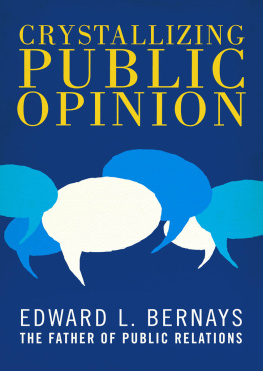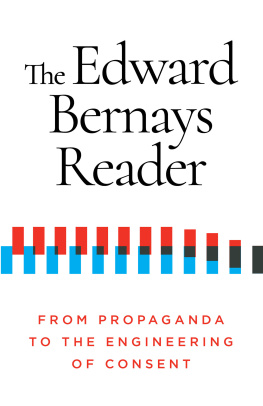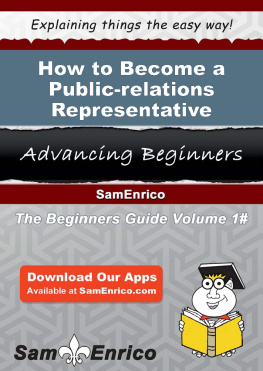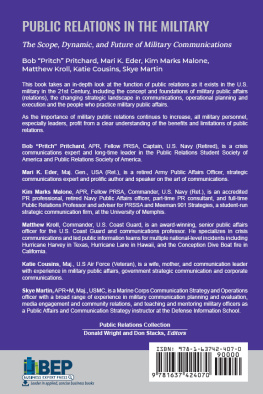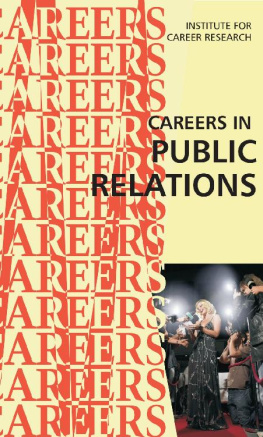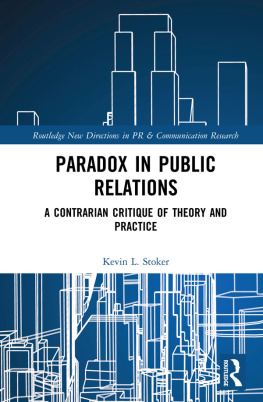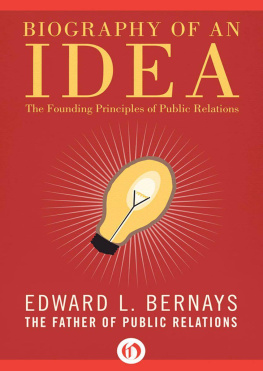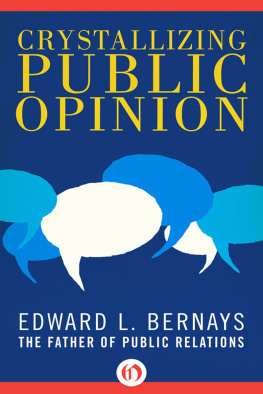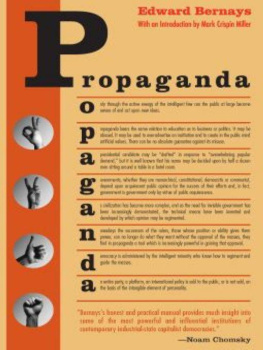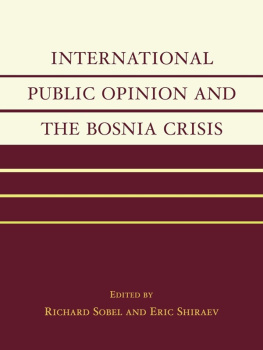Crystallizing Public Opinion
Edward L. Bernays

To My Wife
CONTENTS
INTRODUCTION
I first learned of Edward Bernays in the late 1960s, while I was a graduate student in history beginning to investigate the social roots of American consumer culture. As I read through his writings, I started to grasp his largely unknown influence on the contours of contemporary life. While his life story stood, for the most part, in the shadows of American history, this was the invisible wire puller who had devised many of the powerful ways that the tools of mass persuasion would shape the terrain of American society from the early twentieth century onward.
Beginning his career in the early 1900s, Bernays would soon become one of the most influential pioneers of American public relations, a person whose worldly activities, though not widely known, left a deep mark on the configuration of our world.
Today all of this has changed. Due to a growing interest in the historical relationship between media, culture and society in the modern age, the name of Edward Bernays has become more and more familiar. Since the 1970s, an increasing number of books and films have appeared, and this once covert PR operative has been transformed into an historical figure of controversy and renown.
Born in Vienna in 1891, Bernays was the double nephew of Sigmund Freud. His mother was Freuds elder sister, Anna; his father Ely was Freuds wifes (Martha Bernays Freud) brother. His family background impressed him with the enormous power of intellectual life and accustomed him to the privileges and creature comforts of bourgeois existence.
Bernays was also a farsighted architect of modern propaganda techniques who, dramatically, from the early 1920swhen Crystallizing Public Opinion first appearedhelped to consolidate a fateful marriage between theories of mass and individual psychology and the designs of corporate and political persuasion.
During the First World War, Bernays served as a foot soldier for the U.S. Committee on Public Information (CPI)the vast American propaganda machine mobilized in 1917 to package, advertise and sell the war as one that would Make the World Safe for Democracy. The CPI would become the source from which marketing strategies for subsequent warsincluding the spurious and deadly adventure in Iraqwould flow.
In the twenties, Bernays fathered the link between corporate sales campaigns and popular social causes, whenwhile working for the American Tobacco Companyhe persuaded womens rights marchers in New York City to hold up Lucky Strike cigarettes as symbolic Torches of Freedom. In October of 1929, Bernays also originated the now familiar global media event, when he dreamed up Lights Golden Jubilee, a world-wide celebratory spectacle honoring the fiftieth anniversary of the electric light bulb, sponsoredbehind the scenesby the General Electric Corporation.
Bernayss influence would continue to hold sway well into the postWorld War II era. To put it simply, Bernayss careermore than that of any other individualroughed out what have become the strategies and practices of public relations in the United States and, increasingly, on a global scale.
Alongside the numerous, well-documented campaigns he directedincluding one for the United Fruit Company which led to the 1954 CIA-engineered coup that overthrew the democratically elected president of GuatemalaBernays wrote prolifically.
Propaganda, and The Engineering of Consent, were the self-confident and unabashed writings of a man who was already established as the foremost figure in the public relations fraternity. Both are filled with bold and hyperbolic proclamations, exemplified by the opening paragraph in Propaganda.
The conscious and intelligent manipulation of the organized habits and opinions of the masses is an important element in democratic society. Those who manipulate this unseen mechanism of society constitute an invisible government which is the true ruling power of our country.
In 1923, however, Bernays urgently believed that a case for the practices of public relations in a democratic society still needed to be made. Crystallizing Public Opinion was his presentation of this case, a straightforward manifesto providing a measured and studious argument for the importance of a new profession, which he dubbed the public relations counsel. Much as legal counsels advise and defend clients in the realm of lawthe public relations counsel, as Bernays described himit was always a heprovided expertise to clients on ways to effectively mold public opinion on behalf of their interests. The rise of this new profession, he contended, had already begun to alter the social landscape.
No single profession within the last ten years has extended its field of usefulness more remarkably and touched upon intimate and important aspects of the everyday life of the world more significantly than the profession of public relations counsel.
Bernayss insistence on the importance of defining public relations as a respectable profession was founded on his belief that many people looked upon the practices of publicity with disdain. In this book, Bernays sought to redeem the reputation of public relations and situate it as the intrinsic outcome of a serious intellectual tradition. In naming the book, he drew upon the language of science. Crystallization, in the field of physical chemistry, describes the process by which an amorphous entitya gas or suspension in fluid formis transformed into a solid coherent mass. For Bernays, crystallizing public opinion was about taking an ill-defined, mercurial and changeable group of individual judgments and transforming them into a cohesive and manageable form.
In the book, Bernays portrayed the public relations practitioner as an instrumental social scientist, a resolute student of human motivation. His text books for this study are the facts of life, he claimed, the mental equipment of the average individual.
The public relations counsel, he argued, specialized in understanding the public mind and knowing how to create those circumstances that would gain public attention to consolidate public opinion. A pivotal aspect of the PR counsels wide range of instruments and techniques, as Bernays described them, was an intimate knowledge of those mediums through which public attention is reached and influenced. the channels of thought and communication. In addition to his discussions of newspapers, magazines and the recent development of broadcast radio, Bernayss description of those channels of thought and communication included word-of-mouth networks and the role played by individuals whose opinions influence the outlooks of othersteachers, business leaders, the clergy, etc.
If understanding the dynamics of public opinion was one of his specialties, so too was a comprehension of the railroad tracks along which ideas and opinions travel. An early look at his flair for unseen engineering is found in the work he did in 1913 to foster the success of a controversial play, entitled Damaged Goods, which dealt with the controversial topic of syphilis. This was a time, Bernays wrote in the book that follows, when sexual matters of any kind were not considered appropriate for public discussion. As Bernays noted, Anthony Comstock, who headed the New York Society for the Suppression of Vice, had already closed other shows that he thought too daring.
In order to bypass such Victorian prudery, Bernays created a new organization and enlisted the public support of men and women whose good faith was beyond question and would be responsive to our cause. Turning Damaged Goods into a dramatic brief on behalf of public health these men and womenwho included John D. Rockefeller, Jr.; Simon Flexner, the head of the Rockefeller Institute for Medical Research; Rose Pastor Stokes, an eminent social worker, and Mrs. William K. Vanderbilt, among otherstransformed a potential failure into a major success that eventually gained national press when performed at the White House for President Woodrow Wilson and his high profile guests. In handling publicity for the play, Bernays displayed an uncommon genius social engineering that would define his career and would sharpen the focus of public relations thinking from then on.

